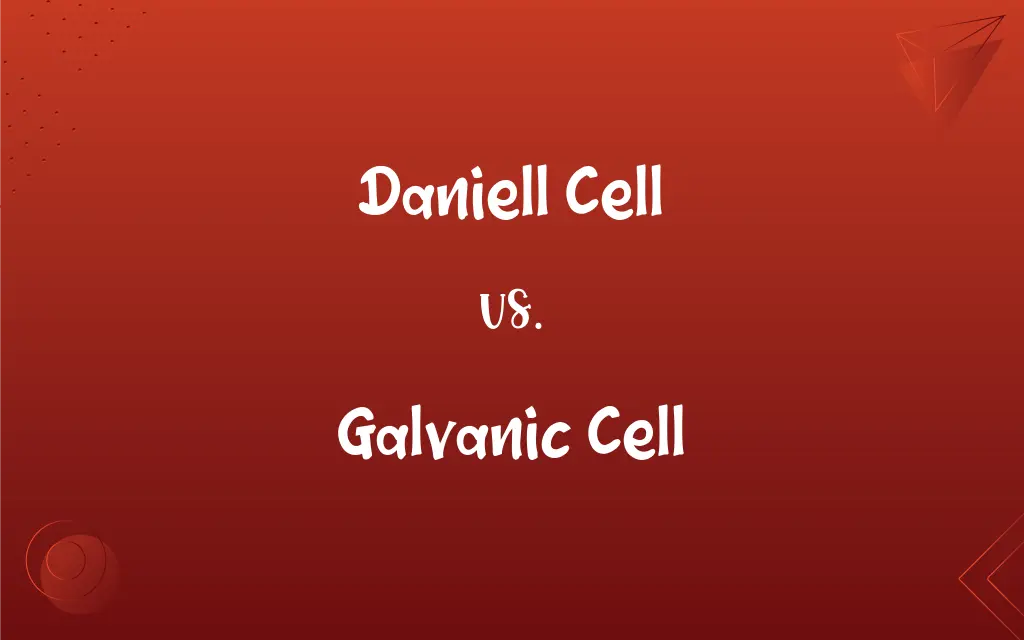Daniell Cell vs. Galvanic Cell: What's the Difference?
Edited by Aimie Carlson || By Harlon Moss || Updated on October 21, 2023
A Daniell cell is a specific type of galvanic cell using copper and zinc electrodes. A galvanic cell is a device that converts chemical energy to electrical energy via spontaneous redox reactions.

Key Differences
Both the Daniell cell and the galvanic cell have an essential role in electrochemistry, serving as foundational concepts for understanding spontaneous redox reactions and the conversion of chemical energy into electrical energy.
The Daniell cell, named after John Frederic Daniell, is a specific type of galvanic cell that employs copper and zinc electrodes submerged in their respective sulfate solutions. This setup results in a predictable voltage under standard conditions. In contrast, the term galvanic cell refers to a broader category of electrochemical cells that produce an electric current through a spontaneous chemical reaction.
Every Daniell cell is a galvanic cell, but not all galvanic cells are Daniell cells. The latter is a general term that encompasses numerous configurations and electrode materials, whereas the former refers explicitly to the classic zinc-copper configuration.
The primary purpose of the Daniell cell is often educational, showcasing fundamental principles of electrochemistry in classroom settings. However, the galvanic cell, given its broader definition, has extensive practical applications, ranging from batteries in everyday devices to advanced energy storage systems.
To reiterate, while the Daniell cell is a notable example and historically significant, the galvanic cell encompasses a vast realm of electrochemical cells, each with its unique characteristics, applications, and potentials.
ADVERTISEMENT
Comparison Chart
Definition
Specific type of galvanic cell
Electrochemical cell producing current through redox
Electrodes Used
Copper and zinc
Can be various metals
Scope
Specific configuration
General category
Practical Usage
Mostly educational
Broad applications including batteries
Relation
Subset of galvanic cells
Includes various types of cells, including Daniell
ADVERTISEMENT
Daniell Cell and Galvanic Cell Definitions
Daniell Cell
A classic battery using Zn and Cu in their sulfate solutions.
The Daniell cell provides a consistent voltage under standard conditions.
Galvanic Cell
An apparatus that generates electricity through spontaneous redox reactions.
A battery is a real-world example of a galvanic cell.
Daniell Cell
An early demonstration of converting chemical to electrical energy.
The Daniell cell played a pivotal role in the development of electrochemistry.
Galvanic Cell
A fundamental concept in understanding battery operations.
In the galvanic cell, the anode is oxidized while the cathode is reduced.
Daniell Cell
A primary cell with predictable electrochemical behavior.
Many textbooks feature the Daniell cell due to its historical significance.
Galvanic Cell
An electrochemical cell with a positive cell potential.
The galvanic cell operates until one of the reactants gets exhausted.
Daniell Cell
A specific electrochemical cell with zinc and copper electrodes.
Students often study the Daniell cell in introductory chemistry courses.
Galvanic Cell
A system comprising two half-cells connected by a salt bridge.
The salt bridge in a galvanic cell maintains electrical neutrality.
Daniell Cell
An illustration of spontaneous redox reactions in electrochemical setups.
The Daniell cell exemplifies the principles of electron transfer and potential difference.
Galvanic Cell
A device converting chemical energy into electrical energy.
Every galvanic cell has two electrodes and an electrolyte facilitating the redox reaction.
FAQs
How broad is the category of galvanic cells?
It includes various configurations and electrode materials.
Who is the Daniell cell named after?
John Frederic Daniell.
What does a galvanic cell do?
It converts chemical energy into electrical energy via spontaneous redox reactions.
What is the function of the salt bridge in a galvanic cell?
It allows ion transfer and maintains electrical neutrality.
Which cell has a wider range of applications?
The galvanic cell, given its broader definition and adaptability.
Why are galvanic cells important?
They're foundational in electrochemistry and underpin battery technology.
In which direction do electrons flow in a galvanic cell?
From the anode to the cathode.
Can a Daniell cell be considered a galvanic cell?
Yes, a Daniell cell is a specific type of galvanic cell.
What is a Daniell cell?
It's a specific type of galvanic cell with zinc and copper electrodes.
What solutions are used in a Daniell cell?
Zinc sulfate and copper sulfate solutions.
What voltage does a Daniell cell produce under standard conditions?
Approximately 1.1 volts.
Are there any alternatives to the Daniell cell in education?
Yes, many other electrochemical setups can illustrate the same principles.
How do modern batteries differ from the basic galvanic cell?
They often have advanced materials, configurations, and can be rechargeable.
Can a galvanic cell be rechargeable?
Yes, but not all. Rechargeable versions are called secondary cells.
What happens at the anode of a Daniell cell?
Zinc undergoes oxidation.
What's the significance of the electrode potential in a galvanic cell?
It determines the voltage and direction of electron flow.
Why is the Daniell cell historically important?
It was an early, stable source of electricity and advanced electrochemistry.
Can any redox reaction power a galvanic cell?
Only spontaneous redox reactions can power a galvanic cell.
Are there practical applications for the Daniell cell today?
It's mainly educational now, though historically it had practical uses.
Is the salt bridge necessary in a Daniell cell?
Yes, it completes the circuit and allows ion transfer.
About Author
Written by
Harlon MossHarlon is a seasoned quality moderator and accomplished content writer for Difference Wiki. An alumnus of the prestigious University of California, he earned his degree in Computer Science. Leveraging his academic background, Harlon brings a meticulous and informed perspective to his work, ensuring content accuracy and excellence.
Edited by
Aimie CarlsonAimie Carlson, holding a master's degree in English literature, is a fervent English language enthusiast. She lends her writing talents to Difference Wiki, a prominent website that specializes in comparisons, offering readers insightful analyses that both captivate and inform.































































